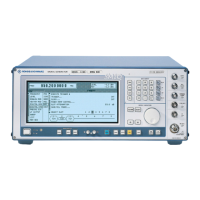1125.5610.12-08 A E-1
Supplement to Manual SMIQ
Output Mode
NORMAL This mode corresponds to that of the previous SMIQ.
LOW NOISE: The modulation in the SMIQ is set so that the power of the second and following
adjacent channels (ALT1...) is minimal.
LOW DIST: The modulation in the SMIQ is set so that the power of the first adjacent channel
(ADJ) is minimal. This optimization takes into consideration the modulation signal
and the version-dependent parameters of the module at 2 GHz.
Hints for the individual modes:
CW: The output mode has no effect in this mode.
VECTOR MOD: With the LOW NOISE output mode, you should additionally raise the IQ level
applied (max. 1 V p). The optimal IQ level with LOW DIST depends on the
modulation signal and must be ascertained through measurements. The adjacent
channel power for symbol rates <200 kHz is essentially determined through
multiplicative phase noise. The IQ level can be set to 250 mV p independent of the
modulation signal.
The level error caused by a change in the IQ level can be corrected with the
LEVEL OFFSET.
ARB MOD: With the LOW NOISE / LOW DIST output mode, the modulation in the SMIQ only
changes by a fixed amount. The user can vary the IQ level in order to achieve the
best results with LOW DIST as a function of the modulation signal.
FADSIM/NDSIM: If these modules are activated, the output mode has no effect. If FSIM is activated,
the adjacent channel power can be optimized by the parameter "Insertion Loss
Setting Mode" in the FADSIM menu.
Additional hints:
The specifications for the level accuracy and harmonic ratio are only valid for the NORMAL output
mode; in the other modes they can change.
IEC/IEEE-bus command: SOURce:POWer[:LEVel]:OMODe NORMal
|LDIStortion
|LNOise

